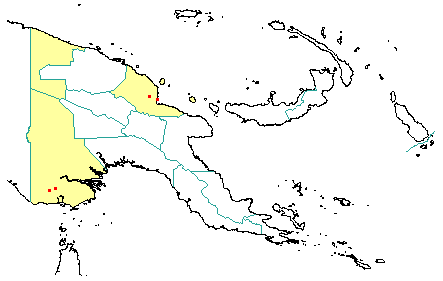
in PNGplants database
PNGTreesKey – Vitex helogiton K.Schum. |
Barry Conn (NSW) & Kipiro Damas (LAE).
Guide to trees of Papua New Guinea
Copyright held by the authors, National Herbarium of New South Wales, and Papua New Guinea National Herbarium
Nachträge zur Flora der Deutschen Schutzgebiete in der Südsee 369 (1905)
Other Literature: A.A. Munir, Journal of the Adelaide Botanic Gardens 48-52 (1987) Fig. 4.
Family: Lamiaceae
Dicotyledon
Timber Group: Non-timber species
Field Characters: Large canopy tree (rarely up to 30 m high) or Small sub-canopy tree (up to 20 m high); Bole cylindrical (up to c. 70 cm diam.); straight (bole 8-15 m long); buttresses buttresses absent; spines spines absent; aerial roots aerial roots absent; stilt roots stilt roots absent; Bark pale brown or brownish grey, rough, scaly or flaky or fissured; Subrhytidome (under-bark) green or brown; less than 25 mm thick; bark blaze consisting of one layer; faintly to non-aromatic; outer blaze yellow (pale (straw-coloured) or white, markings absent; inner blaze white or yellow (pale (straw-coloured), markings absent; bark exudate (sap) absent; terminal buds not enclosed by leaves.
Indumentum: Complex hairs absent; stinging hairs absent; mature twig indumentum (hairs) present, hairs dense (hairs short, adpressed and antrorse).
Leaves: Leaves spaced along branches, opposite (in pairs, opposite one another on the branchlet), compound (a leaf made up from two or more leaflets); petiole present, not winged, attached to base of leaf blade, not swollen; leaves palmate (with more than three leaflets attached at one point to the stalk) (with 4 or 5 leaflets) or with three leaflets (trifoliate); petiolule not swollen; leaves broadest at or near middle, (3.0-) 5.0-17.0 (-22.0) cm, (2.0-) 3.0-7.0 (-9.0) cm, leaflets arranged from one point, asymmetric; venation pinnate, secondary veins open, prominent, intramarginal veins absent; leaves lower surface pale green, upper surface green (glossy), indumentum (hairs) present, indumentum (hairs) sparse (mostly restricted to midrib and secondary veins, hairs minute); absent; domatia present, scattered along midrib; stipules absent.
Flowers: Inflorescence axillary, flowers on a branched axis, cones absent; flowers bisexual, stalked, flowers with one plane of symmetry, 10.0-12.0 mm long, diameter small (up to10 mm diam.) (5-6 mm diam.); perianth present, with distinct sepals and petals whorls (both sepals and petals hairy), inner perianth pale mauve, pale purple, or purplish cream-coloured; 5, some or partly joined; stamens 4, present, free of each other, joined to the perianth; ovary superior, carpels joined (when more than one), locules 2-(sometimes)-4; styles solitary, 1.
Fruits: Infrutescence arranged on branched axis, fruit 8.0-15.0 (-20.0) mm long, 6.0-10.0 (-12.0) mm diam., purple or purplish red, not spiny, fleshy, simple, indehiscent, drupe; seeds 4, to about 5 mm long (5-6 mm long), not winged, narrow (longer than wide), seed 1-10 mm diam. (3-4 mm diam.).
Distribution: West Sepik, Madang & Western.
 | Botanical records in PNGplants database |
Notes: Notes This species has frequently been misidentified as Vitex quinata or included in a broad concept of V. glabrata. Vitex glabrata has broadly elliptic leaflets that have more rounded bases and apices than V. helogiton and the ovary is glabrous. Whereas, V. helogiton has narrowly elliptic leaflets that are gradually tapering to the base and apex, and the ovary is distally hairy. Vitex glabrata is restricted to northern Australia. Vitex quinata can be distinguished by its obovate leaflets, terminal inflorescence, and glandular ovary.
Vitex was previously classified in the Verbenaceae. It is now regarded as a member of the Lamiaceae subfamily Viticoideae.